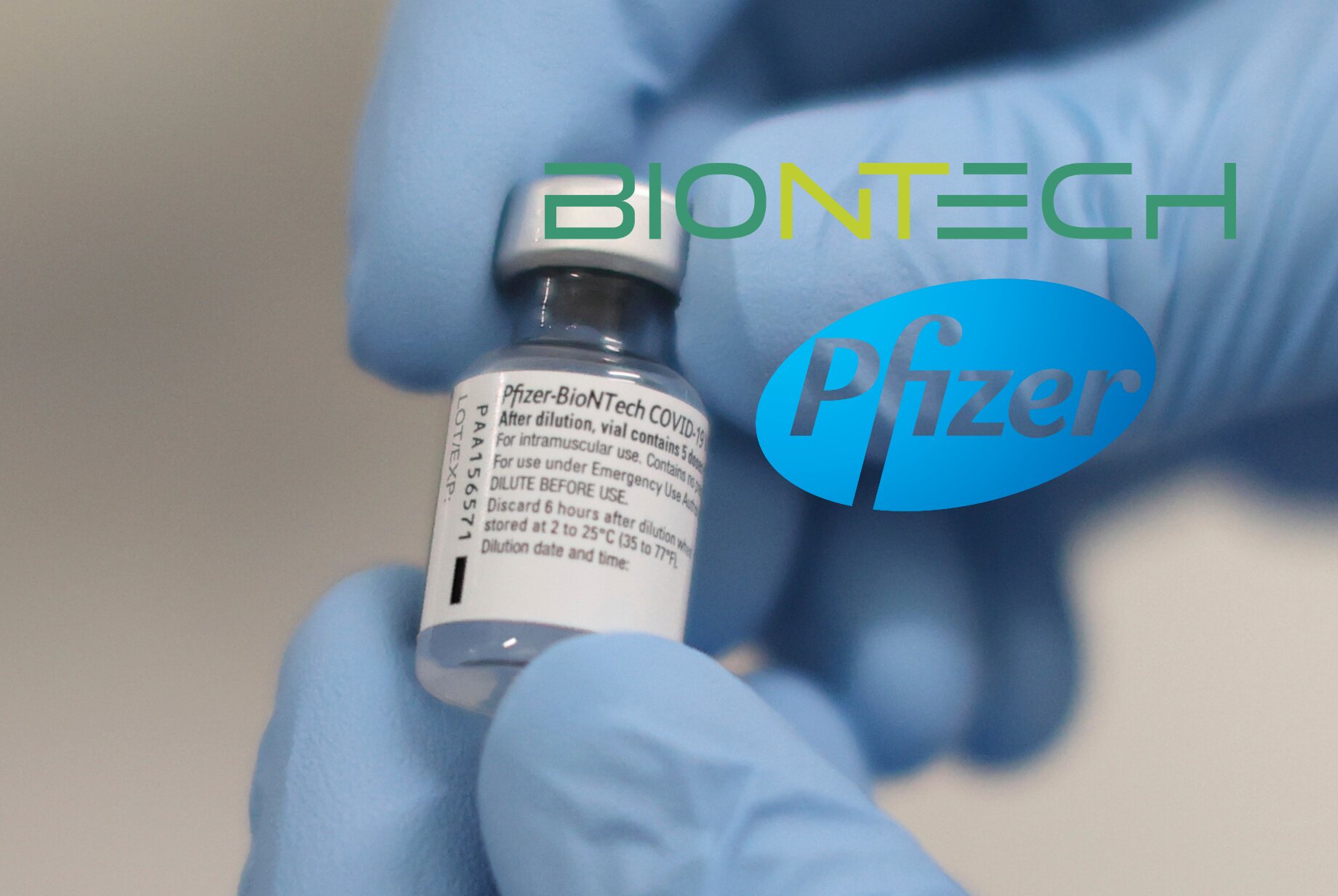Pfizer–BioNTech COVID-19 vaccine – Comirnaty (BNT162b2)
General considerations on mRNA vaccines
The advantage of RNA-based vaccines is their potential for rapid development and reduced side effects. mRNA-based vaccines avoid the risk of integration with the host cell genome and are able to produce pure viral protein. mRNA is transiently expressed, therefore allowing protein to be made within the cell. Lipid nanoparticle (LNP)-formulated mRNA vaccine technology allows the delivery of precise genetic information together with an adjuvant effect to antigen-presenting cells. It is molecularly well
defined, free from materials of animal origin, and synthesized by an efficient, cell-free in vitro transcription process from DNA templates. The technology associated with this vaccine is also capable of bypassing time-consuming standardization processes, thus speeding up its commercial production.
The fast and highly scalable mRNA manufacturing and LNP formulation processes enable rapid production of many vaccine doses, making it suitable for rapid vaccine development and pandemic vaccine supply.
Vaccine characteristics
The Pfizer-BioNTech COVID-19 vaccine, named BNT162b2, encodes a P2 mutant spike protein (PS2) and is formulated as an RNA-lipid nanoparticle (LNP) of nucleoside-modified mRNA (modRNA). BNT162b2 elicits a blunted innate immune sensor activating capacity and thus augments antigen expression. Encapsulation into LNPs enables transfection of the mRNA into host cells after IM injection.
During mixing of the RNA and the dissolved lipids, the lipids form the nanoparticles encapsulating the RNA. After injection, the LNPs are taken up by the cells, and the RNA is released into the cytosol. In the cytosol, the RNA is translated into the encoded viral protein. RNA-expressed S is being degraded intracellularly, the resulting peptides can be presented at the cell surface, triggering a specific humoral T cell mediated immune response with activity against the virus.
Development process, contents, formulation
BNT162b2 is a messenger ribonucleic acid (mRNA) vaccine produced as a highly It is a highliy purified single-stranded, 5`-capped mRNA that has been generated through in vitro transcription in cell-free conditions from the corresponding DNA. The mRNA encodes the viral spike (S) from SARS-CoV-2.
The following excipients are included:
- ALC-0315, ALC-0159 (polyethylene glycole),
- cholesterol,
- potassium chloride,
- potassium dihydrogen phosphate,
- sodium chloride,
- disodium hydrogen phosphate dihydrate, sucrose, and water for injections.
Efficacy against severe Covid-19
A total of 10 cases of severe Covid-19 occurred in trial participants, 1 in the vaccinated group and 9 in the placebo group (VE 88.9%, 95% CI 20.1%, 99.7%). Of these cases, 5 occurred 7 or more days after the second vaccine dose, 1 in the vaccine group and 4 in the placebo group (VE 75%, 95% CI -152.6% to 99.5%).
The Pfizer–BioNTech COVID-19 vaccine (INN: tozinameran), sold under the brand name Comirnaty, is an mRNA-based COVID-19 vaccine. It is authorized for use in people aged 12 years and older in some jurisdictions and for people 16 years and older in other jurisdictions, to provide protection against infection by the SARS-CoV-2 virus, which causes COVID-19. BioNTech, a German company, developed the vaccine and collaborated with Pfizer, an American company, for support with clinical trials, logistics, and manufacturing. In China, BioNTech is partnered with China-based Fosun Pharma for development, marketing, and distribution rights and the vaccine is colloquially described as the Fosun–BioNTech COVID‑19 vaccine.The vaccine is given by intramuscular injection. It is composed of nucleoside-modified mRNA (modRNA) encoding a mutated form of the full-length spike protein of SARS-CoV-2, which is encapsulated in lipid nanoparticles. Vaccination requires two doses given three weeks apart.
The vaccine was the first COVID‑19 vaccine to be authorized by a stringent regulatory authority for emergency use and the first cleared for regular use. In December 2020, the United Kingdom was the first country to authorize its use on an emergency basis. It is authorized for use at some level in 84 countries including the United States and Canada, countries in the European Union, the United Kingdom, Australia, Ukraine, Israel, Brazil, Bangladesh, Mexico, Japan and Singapore.
Vaccine technology
The BioNTech technology for the BNT162b2 vaccine is based on use of nucleoside-modified mRNA (modRNA) which encodes a mutated form of the full-length spike protein found on the surface of the SARS-CoV-2 virus, triggering an immune response against infection by the virus protein.
Composition
In addition to the mRNA molecule, the vaccine contains the following inactive ingredients (excipients):
- ALC-0315, ((4-hydroxybutyl)azanediyl)bis(hexane-6,1-diyl)bis(2-hexyldecanoate),
- ALC-0159, 2-[(polyethylene glycol)-2000]-N,N-ditetradecylacetamide,
- 1,2-distearoyl-sn-glycero-3-phosphocholine (DSPC),
- cholestero,l
- dibasic sodium phosphate dihydrate,
- monobasic potassium phosphate,
- potassium chloride,
- sodium chloride,
- sucrose,
- water for injection.
The first four of these are lipids. The lipids and modRNA together form nanoparticles that act as adjuvants.[102] ALC-0159 is a polyethylene glycol conjugate, i.e., a PEGylated lipid.
The vaccine is supplied in a multidose vial as “a white to off-white, sterile, preservative-free, frozen suspension for intramuscular injection”. It must be thawed to room temperature and diluted with normal saline before administration.
Clinical trials and vaccine efficacy
Phase I–II Trials were started in Germany on 23 April 2020, and in the U.S. on 4 May 2020, with four vaccine candidates entering clinical testing.[35][36] The vaccine candidate BNT162b2 was chosen as the most promising among three others with similar technology developed by BioNTech. Before choosing BNT162b2, BioNTech and Pfizer had conducted Phase I trials on BNT162b1 in Germany and the United States, while Fosun performed a Phase I trial in China. In these Phase I studies, BNT162b2 was shown to have a better safety profile than the other three BioNTech candidates.
The Phase III trial assesses the safety, efficacy, tolerability, and immunogenicity of BNT162b2 at a mid-dose level (two injections separated by 21 days) in three age groups: 12–15 years, 16–55 years or above 55 years. The Phase III results indicating a 95% efficacy of the developed vaccine were published on 18 November 2020. For approval in the EU, an overall vaccine efficacy of 95% was confirmed by the EMA. The EMA clarified that the second dose should be administered three weeks after the first dose.



OF NATURAL PRODUCTS AND EXTRACTS


